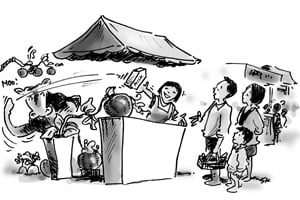While we study populations, at .id we’re interested in all aspects of community life and how different communities organise certain aspects of their lives. While in Japan I’ve been watching the local food system, it’s a different system to our fresh food markets. Rather than the Australian system of large food producers, wholesale markets then retailers buying and selling to the public, the Japanese fresh food system is much more localized.

The key to the Japanese system is the small food markets in each town where the local farmers drop off their produce each day and collect any lefto
vers of an evening. This allows the market to only require one or two check out staff, the farmers freedom and flexibility during the day, and consumers the freshest, cheapest local produce. With such a simple supply chain, even the big supermarkets can’t compete on price.

As I understand it, many small local providers (often farmers) register with the market which then allocates them their own produce boxes. Each provider generates barcodes and ingredients labels for all products to be sold and ensures each item is labelled correctly. I’ve noticed that the providers create their labels in advance so that there are no delays of a morning when delivering stock. The providers themselves set individual prices for their products. A percentage of the sale price goes back to the market.
Early each morning the providers deliver their fresh produce all bagged and tagged in their plastic boxes to the market and place them directly onto the shelves. Then they enter into the system what they have delivered. If a product runs out the provider will get a text message about what has run out and they can decide if they will bring more or not. At the end of the day they get a text if they have any stock left to collect.

For the consumer this has to be the best way to get local produce as most often it is picked the evening before it is sold. I’ve seen cucumbers, beans and peppers picked in the evening, bagged and tagged after dinner then delivered to the market before breakfast. And it’s not limited to raw produce. Many providers value add, like making sweets rice cakes, bento boxes (meal packs) and other foods with their primary produce. I regularly witness fresh food prepped in the evening, cooked and delivered to market with a second batch done before lunch if required. Plants, arts and crafts are also available at the markets and sold in the main building where daily restocking is not so necessary.
The system seems to rely on farmers with small plots of land. With all products labelled by the providers you know exactly who you are buying from. The providers also seem to avoid directly competing rather they look to expand their range.
Importantly, this system of exchange creates and enhances a sense of local community, with providers meeting for a chat when they drop off their produce and also being directly in contact with customers. As many farmers in Japan are elderly, this is one important way in which they keep active in the community.
If you have a story about food production and/or distribution from your local area, or from your travels, we’d love to hear about it and share it with our readers… just leave a comment.
